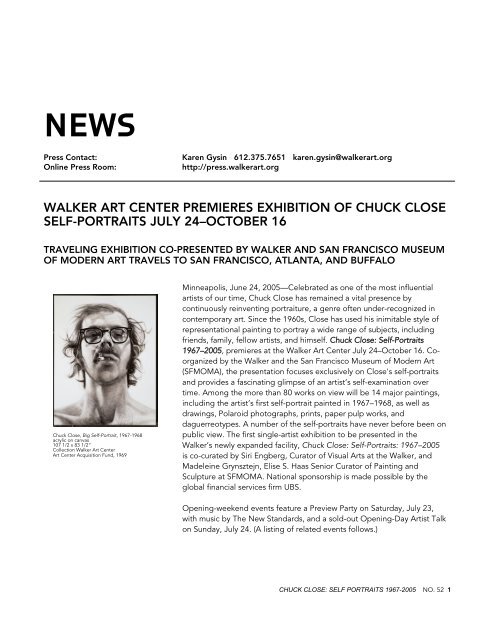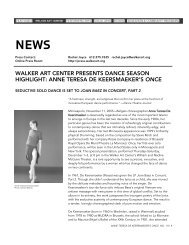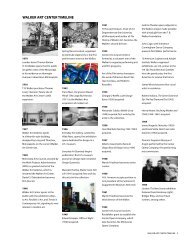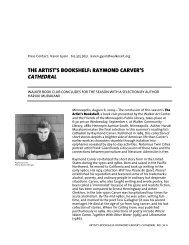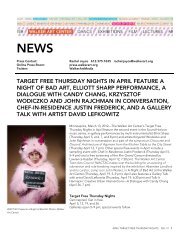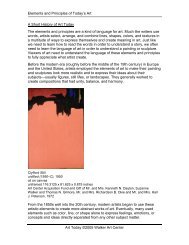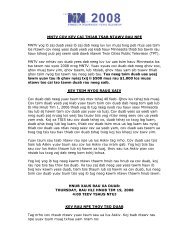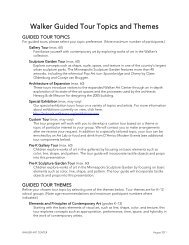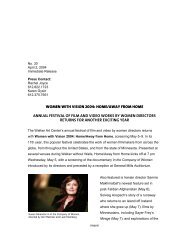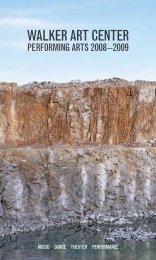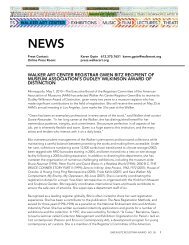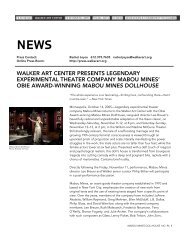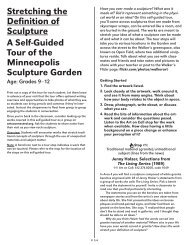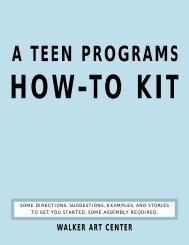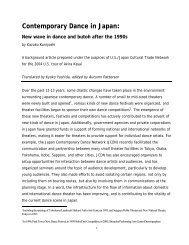walker art center premieres exhibition of chuck close self-portraits ...
walker art center premieres exhibition of chuck close self-portraits ...
walker art center premieres exhibition of chuck close self-portraits ...
Create successful ePaper yourself
Turn your PDF publications into a flip-book with our unique Google optimized e-Paper software.
NEWS<br />
Press Contact: Karen Gysin 612.375.7651 karen.gysin@<strong>walker</strong><strong>art</strong>.org<br />
Online Press Room: http://press.<strong>walker</strong><strong>art</strong>.org<br />
WALKER ART CENTER PREMIERES EXHIBITION OF CHUCK CLOSE<br />
SELF-PORTRAITS JULY 24–OCTOBER 16<br />
TRAVELING EXHIBITION CO-PRESENTED BY WALKER AND SAN FRANCISCO MUSEUM<br />
OF MODERN ART TRAVELS TO SAN FRANCISCO, ATLANTA, AND BUFFALO<br />
Chuck Close, Big Self-Portrait, 1967-1968<br />
acrylic on canvas<br />
107 1/2 x 83 1/2”<br />
Collection Walker Art Center<br />
Art Center Acquisition Fund, 1969<br />
Minneapolis, June 24, 2005—Celebrated as one <strong>of</strong> the most influential<br />
<strong>art</strong>ists <strong>of</strong> our time, Chuck Close has remained a vital presence by<br />
continuously reinventing portraiture, a genre <strong>of</strong>ten under-recognized in<br />
contemporary <strong>art</strong>. Since the 1960s, Close has used his inimitable style <strong>of</strong><br />
representational painting to portray a wide range <strong>of</strong> subjects, including<br />
friends, family, fellow <strong>art</strong>ists, and him<strong>self</strong>. Chuck Close: Self-Portraits<br />
1967–2005, <strong>premieres</strong> at the Walker Art Center July 24–October 16. Coorganized<br />
by the Walker and the San Francisco Museum <strong>of</strong> Modern Art<br />
(SFMOMA), the presentation focuses exclusively on Close's <strong>self</strong>-<strong>portraits</strong><br />
and provides a fascinating glimpse <strong>of</strong> an <strong>art</strong>ist’s <strong>self</strong>-examination over<br />
time. Among the more than 80 works on view will be 14 major paintings,<br />
including the <strong>art</strong>ist’s first <strong>self</strong>-portrait painted in 1967–1968, as well as<br />
drawings, Polaroid photographs, prints, paper pulp works, and<br />
daguerreotypes. A number <strong>of</strong> the <strong>self</strong>-<strong>portraits</strong> have never before been on<br />
public view. The first single-<strong>art</strong>ist <strong>exhibition</strong> to be presented in the<br />
Walker’s newly expanded facility, Chuck Close: Self-Portraits: 1967–2005<br />
is co-curated by Siri Engberg, Curator <strong>of</strong> Visual Arts at the Walker, and<br />
Madeleine Grynsztejn, Elise S. Haas Senior Curator <strong>of</strong> Painting and<br />
Sculpture at SFMOMA. National sponsorship is made possible by the<br />
global financial services firm UBS.<br />
Opening-weekend events feature a Preview P<strong>art</strong>y on Saturday, July 23,<br />
with music by The New Standards, and a sold-out Opening-Day Artist Talk<br />
on Sunday, July 24. (A listing <strong>of</strong> related events follows.)<br />
CHUCK CLOSE: SELF PORTRAITS 1967-2005 NO. 52 1
Chuck Close, Self-Portrait, 2000-2001<br />
oil on canvas<br />
108 x 84”<br />
Collection The Art Supporting Foundation to<br />
the San Francisco Museum <strong>of</strong> Modern Art<br />
Chuck Close, Self-Portrait/String, 1983<br />
handmade paper pulp in 24 gray values and string<br />
37 x 27”<br />
Courtesy <strong>of</strong> the <strong>art</strong>ist<br />
Through more than 35 years <strong>of</strong> “isms” and <strong>art</strong> movements, Close has<br />
remained committed to rigorous experimentation within his own carefully<br />
defined practice, and has regularly returned to his own image as a<br />
touchstone for his work at large. In examining this focused body <strong>of</strong> his<br />
work, Chuck Close: Self-Portraits 1967–2005 highlights how an <strong>art</strong>ist can<br />
create a remarkable pictorial language that continues to become richer<br />
and expand through time. “In almost every medium Close has<br />
explored—painting, drawing, photography, paper pulp, and<br />
printmaking—he has made <strong>self</strong>-<strong>portraits</strong>,” says Engberg. “These form a<br />
complex and compelling body <strong>of</strong> work, in which one not only witnesses a<br />
face changing over time, but sees the st<strong>art</strong>ling visual possibilities a familiar<br />
image can engender.”<br />
The <strong>exhibition</strong> progresses in loosely chronological order and is framed by<br />
two major paintings: the monumental black-and-white Big Self-Portrait<br />
(1967-1968)—the <strong>art</strong>ist’s first—which the Walker purchased out <strong>of</strong> his<br />
studio in 1969, and which was the first <strong>of</strong> Close’s paintings to enter a<br />
museum collection; and SFMOMA’s Self-Portrait (2000-2001), a<br />
contemporary image painted as a mosaic <strong>of</strong> dazzling color, and one <strong>of</strong><br />
only a few <strong>self</strong>-<strong>portraits</strong> painted at the scale <strong>of</strong> the 1968 canvas. The<br />
Walker presented Close’s first major retrospective in 1980. Both<br />
institutions have a long history <strong>of</strong> collecting and exhibiting the <strong>art</strong>ist’s<br />
work.<br />
Born in Monroe, Washington, in 1940, Close graduated from the<br />
University <strong>of</strong> Washington in Seattle in 1962. He graduated from the Yale<br />
University School <strong>of</strong> Art and Architecture in 1964 where he studied<br />
alongside a talented group <strong>of</strong> fellow <strong>art</strong>ists, including Richard Serra, Nancy<br />
Graves, Brice Marden, and Robert Mangold. His paintings at the time<br />
were influenced by the work <strong>of</strong> Arshile Gorky and Willem de Kooning, but<br />
he remained dissatisfied with abstraction’s open-endedness, and the<br />
nagging feeling that he was painting what <strong>art</strong> should look like. While in<br />
school, he traveled regularly to New York, became enthusiastic about Pop<br />
<strong>art</strong>, and began to feel an urgency about pushing his work in a new<br />
direction.<br />
By 1967, Close had moved to New York City and abandoned the abstract<br />
work <strong>of</strong> his school years to begin painting from photographs. “I wanted<br />
something very specific to do, where there were rights and wrongs,” he<br />
has remarked, “and so I decided to just use whatever happened in the<br />
photograph. Whatever shapes were there I would have to use . . . I was<br />
constructing a series <strong>of</strong> <strong>self</strong>-imposed limitations that would guarantee that<br />
I could no longer make what I had been making.”<br />
In 1968, Close completed the watershed painting Big Self-Portrait, his first<br />
<strong>self</strong>-portrait and the first <strong>of</strong> a group <strong>of</strong> eight black and white “heads,” as<br />
he refers to them, which included <strong>portraits</strong> <strong>of</strong> fellow <strong>art</strong>ists Nancy Graves,<br />
Richard Serra, Joe Zucker, and the composer Philip Glass. At the<br />
monumental scale <strong>of</strong> nine by seven feet, Big Self-Portrait is made from<br />
only a few tablespoons <strong>of</strong> water-based pigment, applied thinly so as to<br />
CHUCK CLOSE: SELF PORTRAITS 1967-2005 NO. 52 2
Chuck Close, Self-Portrait Maquette, 1975<br />
black-and-white Polaroid photograph scored<br />
with pencil and masking tape with plastic<br />
overlay<br />
4 x 5”<br />
Courtesy <strong>of</strong> the <strong>art</strong>ist<br />
Chuck Close, Self-Portrait, 1997<br />
oil on canvas<br />
102 x 84”<br />
Collection The Museum <strong>of</strong> Modern Art, New<br />
York<br />
imitate the slick surface <strong>of</strong> its photographic source. It was this series <strong>of</strong><br />
paintings that brought Close instant recognition as an <strong>art</strong>ist, and set the<br />
course for a working method the <strong>art</strong>ist has continued to the present.<br />
Always working from photographs as the basis for his imagery, Close first<br />
produces a maquette, comprising a photograph overlaid with a grid<br />
template. He then proceeds to systematically transpose the image to<br />
another surface—be it canvas, drawing paper, a printing plate, or a paper<br />
pulp collage—square by square. Though his practice is well-defined, it is<br />
far from rigid. Within each square, Close has chosen, as he has remarked,<br />
to consistently “alter the variables” in his work. Whether he fills each<br />
square with delicately airbrushed pigment, dots <strong>of</strong> pastel, inked<br />
fingerprints, etched lines, or organic brushstrokes in vibrant color, he<br />
continues “to find things in the rectangle and slowly sneak up on what I<br />
want . . . to make it all happen in the rectangle instead <strong>of</strong> on the palette<br />
and in context.” Within the broad array <strong>of</strong> <strong>self</strong>-<strong>portraits</strong> featured in this<br />
<strong>exhibition</strong>, Close has used this method to produce works ranging from<br />
large-scale paintings to intimate drawings to elaborate paper pulp<br />
constructions. He is also a master printmaker, and has created <strong>self</strong><strong>portraits</strong><br />
using techniques including etching, woodcut, linoleum block<br />
printing, and screenprinting.<br />
Close has also been an innovator in the arena <strong>of</strong> photography, and the<br />
<strong>exhibition</strong> will contain numerous examples <strong>of</strong> his photographic <strong>self</strong><strong>portraits</strong>.<br />
One <strong>of</strong> the first <strong>art</strong>ists to experiment with the large-format<br />
Polaroid camera, he has created many <strong>portraits</strong> in the medium, including<br />
large-scale collages <strong>of</strong> multiple photographs. In recent years, he has also<br />
embraced the 19th-century daguerreotype technique, which he has used<br />
to create a broad range <strong>of</strong> <strong>portraits</strong>—many <strong>of</strong> his own image—that feel<br />
exceptionally contemporary.<br />
Beginning in 1988, Close faced new personal and <strong>art</strong>istic challenges after<br />
suffering a collapsed spinal <strong>art</strong>ery that initially left him paralyzed from the<br />
neck down. With time and tenacity, his condition improved, and though<br />
dependent on a wheelchair, he was able to begin painting again with a<br />
customized brace. The <strong>self</strong>-<strong>portraits</strong> made following this event became<br />
more gestural than ever before, and continued Close’s explorations into<br />
the use <strong>of</strong> a bold, unexpected color palette. Close is a highly intuitive<br />
colorist, whose paintings have been connected to many <strong>art</strong> historical<br />
precedents, including Byzantine mosaics and the paintings <strong>of</strong> Gustav<br />
Klimt.<br />
Chuck Close: Self-Portraits 1967–2005 is accompanied by a richly<br />
illustrated 144-page catalogue documenting this body <strong>of</strong> Close’s work in<br />
detail and across media, and includes essays by Madeleine Grynsztejn, Siri<br />
Engberg, and Douglas R. Nickel, Director <strong>of</strong> the Center for Creative<br />
Photography, The University <strong>of</strong> Arizona, Tucson. ($34.95; $31.46 Walker<br />
members)<br />
CHUCK CLOSE: SELF PORTRAITS 1967-2005 NO. 52 3
Chuck Close in his studio working on Self-Portrait<br />
(2004-2005)<br />
Photo: Michael Marfione<br />
Related Events<br />
Preview P<strong>art</strong>y: See the Big Picture<br />
Saturday, July 23, 9 pm–12 midnight<br />
$20 ($10 Walker members)<br />
Save $1 per ticket when ordering online.<br />
New members joining for the event receive one free ticket.<br />
612.375.7600 or visit <strong>walker</strong><strong>art</strong>.org/tickets<br />
At this larger-than-life p<strong>art</strong>y celebrating the <strong>exhibition</strong> get a <strong>close</strong> look at<br />
the big picture, hear reimagined classics by The New Standards, take in a<br />
screening <strong>of</strong> Chuck Close: A Portrait in Progress by Marion Cajori, and<br />
enjoy cash bars and complimentary appetizers by Wolfgang Puck Catering<br />
throughout the evening.<br />
Music: The New Standards<br />
10:15–11:45 pm, Gallery 8 Café<br />
From Blur to Bowie, Peggy Lee to Kurt Weill, The New Standards<br />
illuminate new and cherished classics <strong>of</strong> the 20th-century songbook with<br />
the intimate instrumentation <strong>of</strong> piano, vibes, and bass. Chan Poling <strong>of</strong> the<br />
Suburbs, John Munson <strong>of</strong> Semisonic, and Steve Roehm <strong>of</strong> Electropolis.<br />
Screening: Chuck Close: A Portrait in Progress<br />
Directed by Marion Cajori<br />
9:30 and 11 pm, Cinema<br />
Cajori interviews Chuck Close while he’s in the process <strong>of</strong> creating new<br />
work. 1998, U.S., color, video, 57 minutes.<br />
Opening-Day Artist Talk: Chuck Close<br />
Sunday, July 24, 2 pm, $20 ($10 Walker members)<br />
William and Nadine McGuire Theater<br />
SOLD OUT<br />
Chuck Close talks with <strong>exhibition</strong> curators Siri Engberg and Madeleine<br />
Grynsztejn about working with photographs, painting from the grid, and<br />
collaborating with master printers and papermakers.<br />
This event will be webcast live from the Walker’s site at<br />
channel.<strong>walker</strong><strong>art</strong>.org.<br />
This talk is made possible by generous support from Aaron and Carol<br />
Mack.<br />
CHUCK CLOSE: SELF PORTRAITS 1967-2005 NO. 52 4
Harry Mathews<br />
Photo courtesy the <strong>art</strong>ist<br />
Community Forum<br />
Questioning Biography: Personal History, Content, and Aesthetics in Art<br />
Wednesday, September 7, 7 pm, Free<br />
Gallery 8 Café<br />
Is knowing an <strong>art</strong>ist’s biography pivotal to understanding her or his work?<br />
Tom di Maria, executive director <strong>of</strong> Creative Growth, leads a discussion on<br />
the role <strong>of</strong> biography, culture, and disability in <strong>art</strong>-making. As head <strong>of</strong> the<br />
first independent visual <strong>art</strong> <strong>center</strong> for adults with developmental, physical,<br />
mental, and emotional disabilities, he questions the labels used for trained<br />
vs. “outsider” <strong>art</strong>ists, and recognizes that <strong>art</strong>ists with disabilities <strong>of</strong>ten<br />
straddle both worlds while making <strong>art</strong>work that is increasingly recognized<br />
and appreciated.<br />
Target Free Thursday Nights<br />
Free Verse: Harry Mathews<br />
Thursday, September 15, 7 pm, Free<br />
In a st<strong>art</strong>ling riff on the theme <strong>of</strong> <strong>self</strong>-portraiture, legendary<br />
expatriate writer Harry Mathews—reputed to be a CIA agent<br />
due to a series <strong>of</strong> improbable coincidences in the early<br />
1970s—decided to act the p<strong>art</strong>. In his latest novel, My Life in<br />
CIA, Mathews documents the year 1973 as seen through his<br />
would-be agent’s eyes, using his inimitable, experimental style<br />
to make the journey both fascinating and fun.<br />
Mathews is the only American member <strong>of</strong> the Oulipo, France’s<br />
famed “Workshop for Potential Literature.” This group <strong>of</strong> writers<br />
and mathematicians, which included Georges Perec and Italo<br />
Calvino, used writing techniques <strong>of</strong>ten based on mathematical<br />
problems. Mathews is the author <strong>of</strong> numerous works <strong>of</strong> prose<br />
and poetry, including the acclaimed novels Cigarettes and The<br />
Journalist, and the constricted journal 20 Lines A Day.<br />
Free Verse is co-sponsored by Rain Taxi Review <strong>of</strong> Books.<br />
Curator Tour<br />
Thursday, September 22, 6 pm, Free<br />
Meet in the Bazinet Garden Lobby<br />
Join <strong>exhibition</strong> co-curator Siri Engberg for a walk through more<br />
than 80 works <strong>of</strong> <strong>self</strong>-portraiture by Chuck Close. Spanning over<br />
30 years <strong>of</strong> his <strong>art</strong>istic career, this <strong>exhibition</strong> <strong>of</strong> paintings,<br />
drawings, photographs, collages, and prints provides a<br />
fascinating glimpse <strong>of</strong> an <strong>art</strong>ist’s <strong>self</strong>-examination over time.<br />
Art Lab: Drawing on the Grid<br />
Thursdays, September 15, 22, 29, 6–9 pm, Free<br />
Star Tribune Foundation Art Lab<br />
To create his <strong>portraits</strong> <strong>of</strong> roughly 8 x 7 feet in scale, Chuck Close<br />
overlays a smaller photograph with a numbered and lettered<br />
CHUCK CLOSE: SELF PORTRAITS 1967-2005 NO. 52 5
Chuck Close installing the Walker <strong>exhibition</strong> Close<br />
Portraits, 1980<br />
Photo: Walker Art Center Archives<br />
grid. This technique, devised by Renaissance masters, allows the<br />
<strong>art</strong>ist to reproduce the image block by block with resounding<br />
clarity <strong>of</strong> detail. Paint a collective, large-scale portrait in the style<br />
<strong>of</strong> Chuck Close or draw your own enlarged image using digital<br />
photography and the grid.<br />
Target Free Thursday Nights are sponsored by Target.<br />
Free First Saturday<br />
Exhibition Tour<br />
Inspired by Me<br />
Saturday, August 6, 10 am–5 pm, Free<br />
Powerful <strong>portraits</strong> abound as Free First Saturday takes its cue<br />
from the <strong>exhibition</strong>. The daylong event features performances<br />
by teen actors from the Youth Performance Company and<br />
hands-on <strong>art</strong>-making sessions led by <strong>art</strong>ists from Highpoint<br />
Center for Printmaking to make <strong>self</strong>-<strong>portraits</strong>. Workshop<br />
p<strong>art</strong>icipants will draw inspiration from <strong>portraits</strong> on view by<br />
children from Free Arts Minnesota, a nonpr<strong>of</strong>it organization<br />
dedicated to healing at risk children through <strong>art</strong>istic expression.<br />
The event also includes a family tour <strong>of</strong> the <strong>exhibition</strong>, family<br />
<strong>portraits</strong>, and storytelling.<br />
Free First Saturday is sponsored by Coldwell Banker Burnet.<br />
Programming is made possible by the Medtronic Foundation.<br />
Media p<strong>art</strong>ner WCCO TV Channel 4.<br />
Art-making for the Whole Family: Portrait Power is made<br />
possible by generous support from the global financial services<br />
firm UBS.<br />
Walker Art Center<br />
July 24–October 16, 2005<br />
San Francisco Museum <strong>of</strong> Modern Art<br />
November 19, 2005–February 28, 2006<br />
High Museum <strong>of</strong> Art, Atlanta<br />
March 25–June 18, 2006<br />
Albright-Knox Art Gallery, Buffalo, New York<br />
July 22–October 22, 2006<br />
CHUCK CLOSE: SELF PORTRAITS 1967-2005 NO. 52 6
Chuck Close, Self-Portrait, 2004-2005<br />
oil on canvas<br />
102 x 86”<br />
Private Collection, New York<br />
National sponsorship <strong>of</strong> Chuck Close: Self-Portraits 1967–2005 is made<br />
possible by the global financial services firm UBS. UBS, one <strong>of</strong> the world’s<br />
leading financial firms, is the largest wealth manager, a top tier investment<br />
banking and securities firm, a key asset manager, and the leader in Swiss<br />
retail and commercial banking. Headqu<strong>art</strong>ered in Zürich and Basel, UBS<br />
employs over 68,000 people and has <strong>of</strong>fices in 50 countries. It is a Swiss<br />
public company listed on the SWX Swiss Stock Exchange, the New York<br />
Stock Exchange (NYSE), and the Tokyo Stock Exchange (TSE). In the U.S.,<br />
UBS is one <strong>of</strong> the biggest private client businesses with a client base <strong>of</strong><br />
nearly two million private clients and approximately 7,500 financial<br />
advisers in over 350 <strong>of</strong>fices.<br />
Additional support for Chuck Close: Self-Portraits 1967–2005 is provided<br />
by the National Endowment for the Arts and Margaret and Angus<br />
Wurtele.<br />
Walker Art Center programming is made possible by its Premier P<strong>art</strong>ners:<br />
Best Buy, General Mills, Target, Star Tribune, and WCCO-TV.<br />
The Walker Art Center is located at 1750 Hennepin Avenue—where Hennepin meets<br />
Lyndale—one block <strong>of</strong>f Highways I-94 and I-394, Minneapolis.<br />
For public information, call 612.375.7600, or visit <strong>walker</strong><strong>art</strong>.org.<br />
CHUCK CLOSE: SELF PORTRAITS 1967-2005 NO. 52 7


